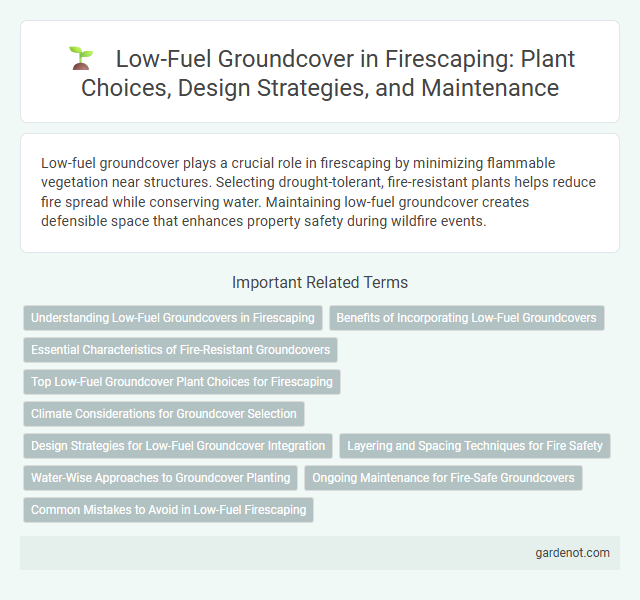Low-fuel groundcover plays a crucial role in firescaping by minimizing flammable vegetation near structures. Selecting drought-tolerant, fire-resistant plants helps reduce fire spread while conserving water. Maintaining low-fuel groundcover creates defensible space that enhances property safety during wildfire events.
Understanding Low-Fuel Groundcovers in Firescaping
Low-fuel groundcovers play a crucial role in firescaping by reducing the amount of combustible material near structures, effectively minimizing wildfire risk. Selecting drought-tolerant, fire-resistant plants such as sedums, ice plants, and certain native grasses helps create a defensible space that slows fire spread. Proper maintenance of low-fuel groundcover, including regular pruning and removal of dead vegetation, is essential for maintaining its fire-resistant properties.
Benefits of Incorporating Low-Fuel Groundcovers
Incorporating low-fuel groundcovers significantly reduces wildfire risk by minimizing available combustible material near structures, enhancing property safety. These drought-tolerant, fire-resistant plants help maintain soil stability while reducing erosion, promoting sustainable landscaping practices. Their ability to act as natural firebreaks improves overall landscape resilience and decreases the likelihood of fast-spreading fires.
Essential Characteristics of Fire-Resistant Groundcovers
Fire-resistant groundcovers possess essential characteristics such as high moisture content, low volatile oils, and slow growth rates that minimize fuel availability during wildfires. These plants typically have succulent leaves or thick, fleshy foliage that resists combustion and heat damage. Selecting low-fuel groundcovers like creeping thyme, sedum, or ice plant can effectively reduce wildfire intensity and protect structures in defensible space zones.
Top Low-Fuel Groundcover Plant Choices for Firescaping
Top low-fuel groundcover plant choices for firescaping include drought-tolerant species like Sedum, creeping thyme, and ice plant, known for their minimal dead material and high moisture content that resist ignition. These plants create effective firebreaks by reducing available fuels and promoting landscape safety near structures. Strategically incorporating fire-resistant groundcovers such as native grasses and succulents enhances overall property defense against wildfires.
Climate Considerations for Groundcover Selection
Selecting low-fuel groundcover is critical for effective firescaping, especially in fire-prone climates where vegetation can significantly influence fire behavior. Native drought-tolerant plants such as succulents and certain grasses with high moisture content reduce fuel loads and enhance fire resistance. Understanding regional climate patterns, including temperature extremes and rainfall variability, ensures groundcover choices maintain resilience and minimize ignition risks.
Design Strategies for Low-Fuel Groundcover Integration
In firescaping, selecting low-fuel groundcover is essential for reducing wildfire risk by minimizing combustible materials near structures. Design strategies emphasize using drought-resistant, fire-retardant plants like sedums, ice plants, and creeping thyme, which maintain moisture and create natural firebreaks. Proper integration includes spacing groundcover to prevent continuous fuel beds and incorporating non-flammable hardscape elements to enhance defensible space.
Layering and Spacing Techniques for Fire Safety
Low-fuel groundcover such as drought-tolerant succulents and native grasses reduces fire risk by minimizing available combustible material. Layering involves placing low-fuel plants near structures with taller, more fire-resistant vegetation farther away to create effective defensible space. Proper spacing between plants prevents fire spread by limiting fuel continuity and promoting safer firebreaks.
Water-Wise Approaches to Groundcover Planting
Low-fuel groundcover in firescaping emphasizes selecting drought-tolerant, water-wise plants that minimize fire risk by maintaining low levels of combustible material. Species such as native succulents, creeping thyme, and ornamental grasses not only conserve water but also create effective firebreaks due to their sparse, moist foliage. Integrating these plants within a well-planned irrigation strategy enhances fire resilience while supporting sustainable landscape management in arid climates.
Ongoing Maintenance for Fire-Safe Groundcovers
Low-fuel groundcovers require regular pruning and removal of dead material to maintain their fire-resistant properties effectively. Consistent watering and monitoring for disease or pest infestations help ensure dense, healthy growth that resists ignition. These ongoing maintenance practices significantly reduce the risk of fire spread around residential areas.
Common Mistakes to Avoid in Low-Fuel Firescaping
Selecting inappropriate low-fuel groundcover species, such as highly flammable plants like juniper or eucalyptus, increases wildfire risk and undermines effective firescaping. Overcrowding plants without adequate spacing can restrict airflow and create continuous fuel beds, facilitating fire spread. Neglecting proper maintenance, including regular pruning and removal of dead material, allows fuel accumulation that compromises fire safety and landscape resilience.
Low-fuel groundcover Infographic

 gardenot.com
gardenot.com